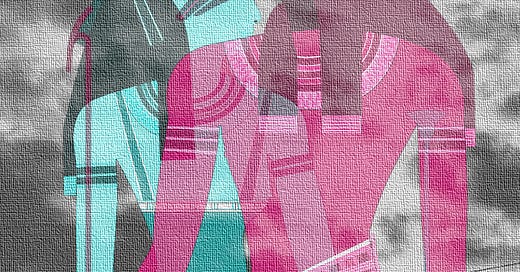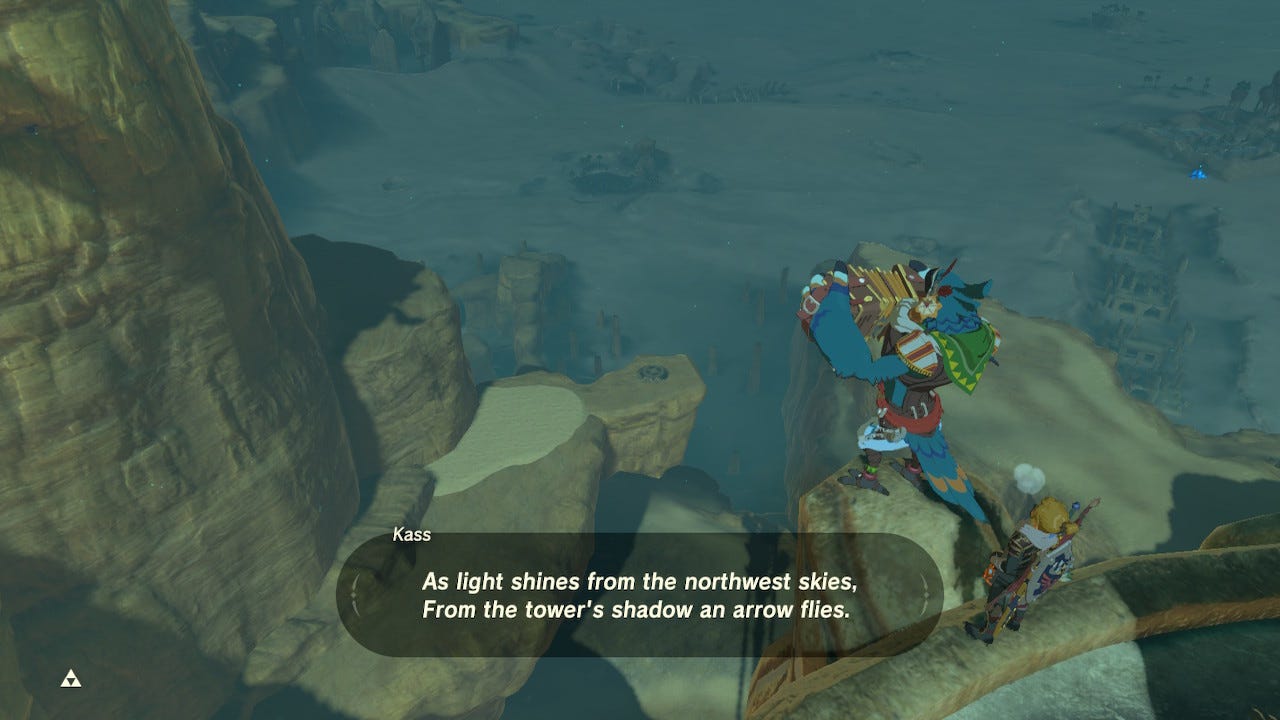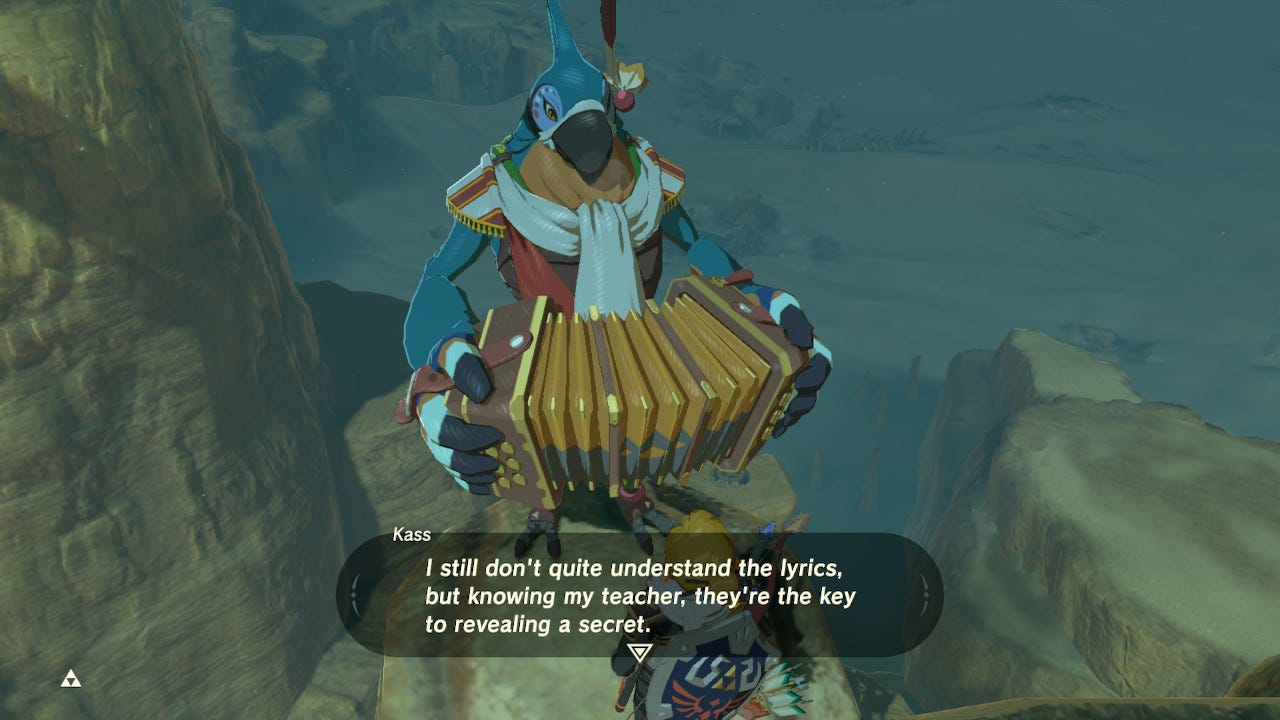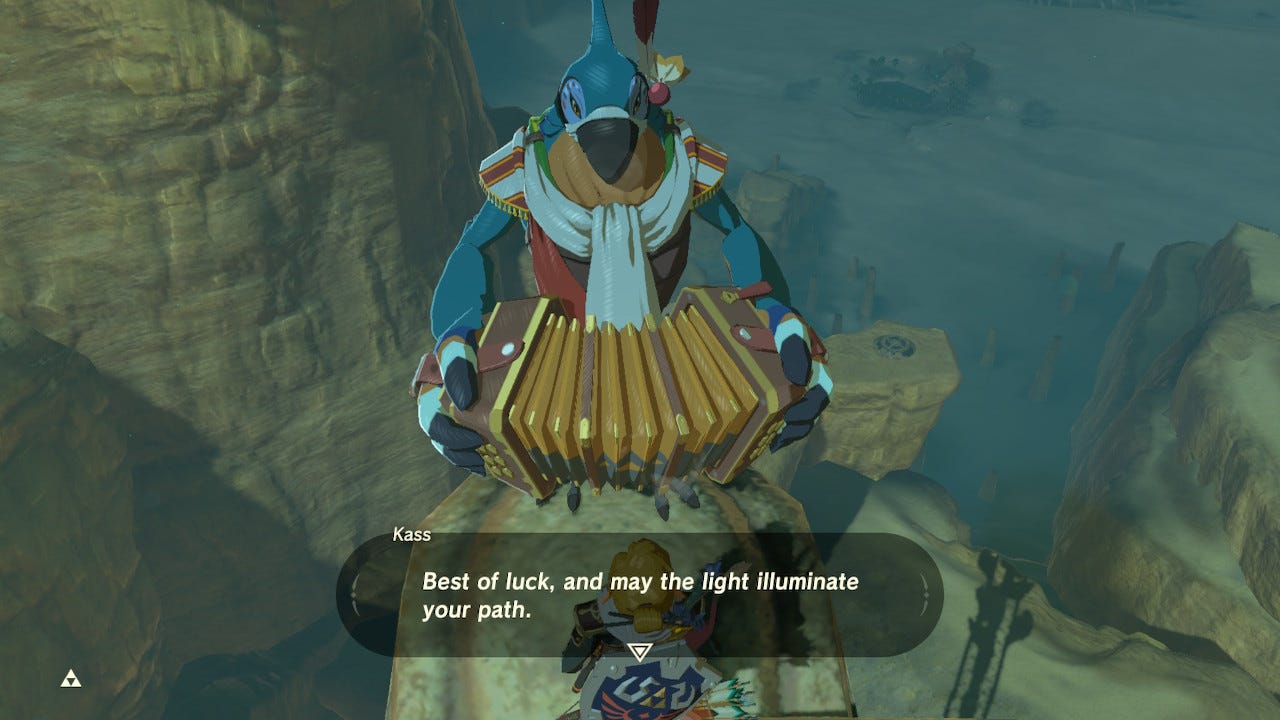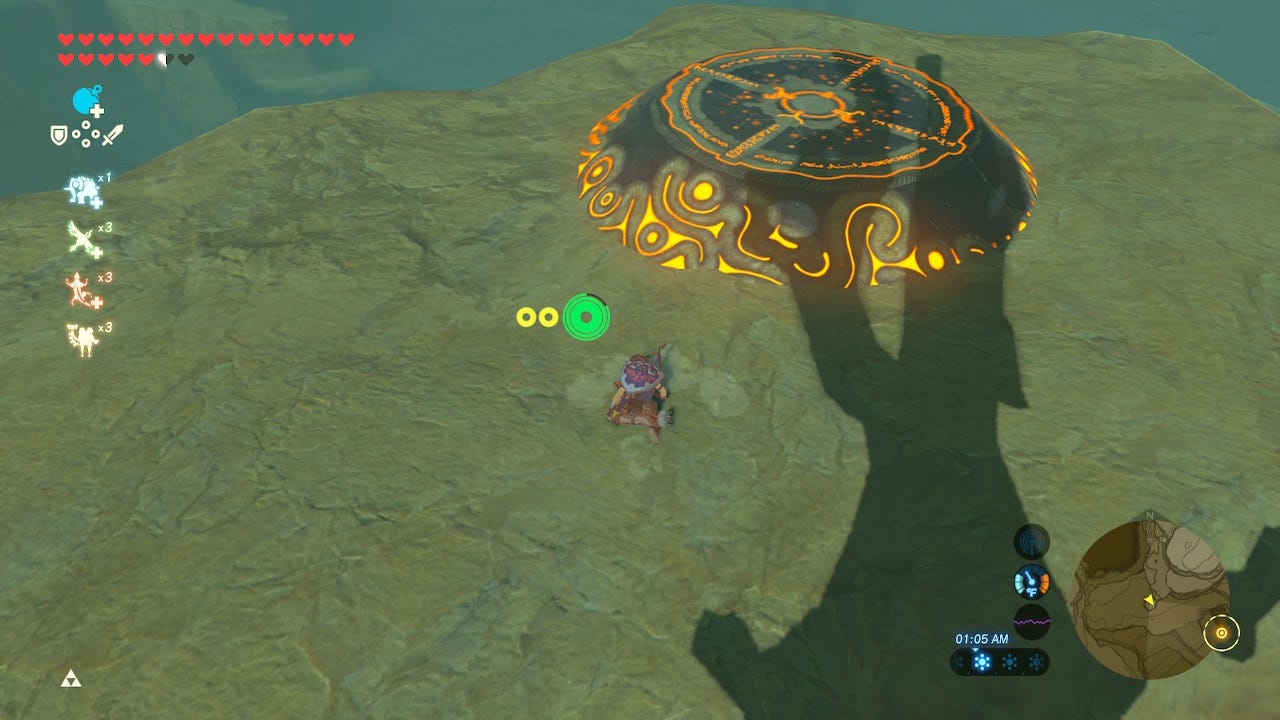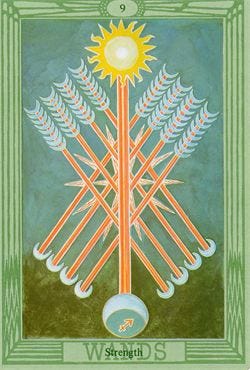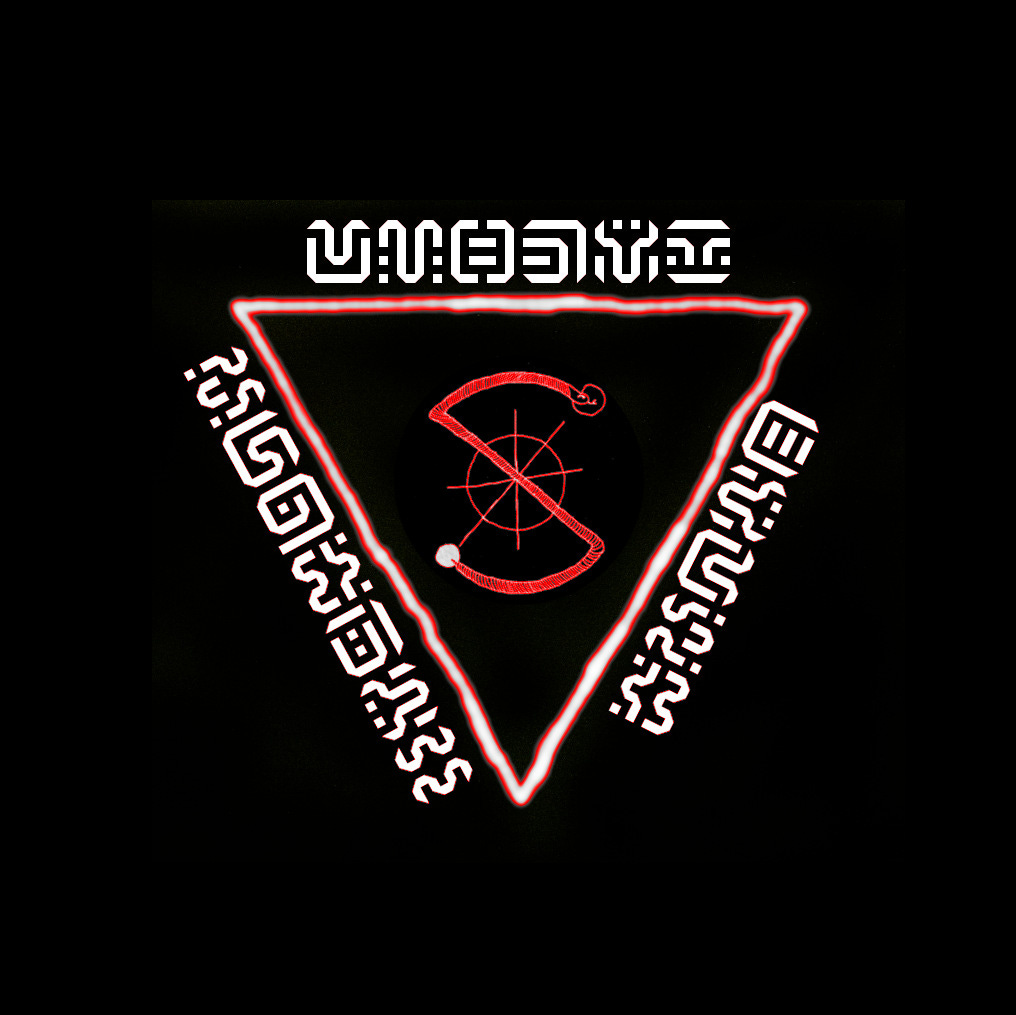I’ve had a much better time of expressing the meaning of The Word of Hermekate over the last three posts than I expected. I’ve definitely had a much smoother time of it than I have in the past, and this is likely owing to…(groan)…the study I’ve done since then. As we’ll see, I still have more study left to do, but I think I’ve seen enough, now, to get a basic understanding of the Aeonic nature of the Word of Hermekate. I’ve said that in this post, I will reveal which Aeon (singular) the Word emanates from, but in reality, it may not be quite that simple.
As I look back, it’s clear that I’ve actually known for quite a while where my Word “lands” in the greater Aeonic scheme of things. I’ve already spelled it out in emails I’ve written to several people. I’ve even been…”foreshadowing” it since I first started writing this Substack, even though my understanding was not yet complete. A major hint is to be found in the image I used in the post Flying Blind, the first post I wrote for Dark Twins.
Dark Twins is a reader-supported publication. To receive new posts and support my work, consider becoming a free or paid subscriber.
The Aeon of Ma’at
In connection with this matter, I also see once again the principle I’ve cited recently (with thanks to Don Webb for having elaborated upon it in Overthrowing the Old Gods: Aleister Crowley and The Book of the Law) of the way in which a Magus can look back on their life and see their Word written in its events:
In 2018, Judith Page and Don Webb released an anthology called Questing SET Digest, which included my article (submitted under my birth name) entitled No Left Turn: On Overcoming Right Hand Path Bias. As one might expect, most of the essays submitted for the book were focused on the Egyptian neter named Set, but there were two essays having more to do with another neter: Ma’at. One of them was a brief letter commemorating the life of Nema Andahadna (Margaret E. Cook by birth, later Ingalls by marriage), who had just passed away a few months before the book was published. The other was a transcribed lecture about the Aeon and current of Ma’at that she had given, which can be read online at this link.
Nema was a treasure to the esoteric community, who worked Thelemic magic(k) and later developed her own system, Ma’at magic(k). She isn’t as well-known as some of her contemporaries in occultism, but her ideas have been cited as influential by such figures as Kenneth Grant and Donald Michael Craig. Those familiar with her work consider her to have been just as great an occultist as any of them.
If she is less well-known, I can think of two likely reasons:
She was fairly devoted to the work itself and didn’t really seek the spotlight.
The message she carried likely rubbed many occultists the wrong way because of its emphasis on the big picture and its way of downplaying the importance of individual egos, and let’s face it: Most occultists have pretty big heads. Self-importance is, shall we say, a prominent feature of most of the magicians we’ve all heard of (which makes perfect sense when you think about it).
Her best-known work is Liber Pennae Praenumbra, “The Book of the Foreshadowing of the Feather,” an inspired text that falls along the same lines as Aleister Crowley’s Liber AL vel Legis (The Book of the Law) and Michael Aquino’s Book of Coming Forth By Night. You can read the text for free online at this link.
I have technically known about the Ma’atian current for many years; I first encountered it online when I was very young, perhaps 14 or 15. I got the basic gist, that Ma’at as a goddess is about justice, truth, balance, the principle of “cosmos” or cosmic harmony/beauty; for a very long time, however, I declined to study Nema’s work mainly because of how much it seemed to depend on a detailed understanding of Thelema—a matter to which I will return later in this post. To this very day, I still have her book, Maat Magick: A Guide to Self-Initiation, on my reading list, along with The Incoming of the Aeon of Maat, a compilation of letters between Frater Achad (Charles Stansfeld Jones), onetime protege of Aleister Crowley himself, and others. However, based on what I have seen thus far, my own magic(k)al gnosis seems to align well with the established doctrine thus far, and I think that writing this post prior to studying those two tomes will be a good further “test” of my gnosis. Let’s face it, I’ve been very fixated on The Aeon of Set for the past several years, and so I’ve admittedly had some tunnel vision.
One good example of the idea of “testing my gnosis” is this: Due to my relative ignorance of documented work done within the Aeon of Ma’at, I did not realize, when naming this Substack, that the Ma’atian current is actually known as “The Twin Current” or “The Double Current.” In my case, the name came from an entirely different context (That of The Hexorian Movement, particularly its emergent godform of Maakari), and the way in which I grabbed hold of Maakari’s “Dark Twin” and conceptualized it as being related to Set/The Prince of Darkness (which I named “The Princess of Darkness” and later, after a character from the eponymous Zelda game, “The Twilight Princess”) suggests to me that I was definitely onto something valid. My gnosis was connecting with something real, but my limited understanding kept me from seeing it accurately for what it was.
The concept of The Twin Current postulates that, despite what Crowley predicted, The Aeon of Ma’at is deeply intertwined with the Aeon of Horus and basically came into being right alongside it.
When did I learn about this? August 21st, 2023—about 7 months after I began writing Dark Twins, and a little over a month after I deleted the site. As it happens, the “revelation” came via the game The Legend of Zelda: Breath of the Wild.
The Sign of the Shadow
Warning: SPOILERS for The Legend of Zelda: Breath of the Wild from here on out.
I had been troubled for a couple of days, feeling conflicted about the Word of Hermekate and the fact that I had stopped writing Dark Twins and had tried to put both the Word and the writing out of my mind. It wasn’t working out well.
One of the main points of tension was the fact that I had thus far tried very hard to cast my Word into the mold of the Aeon of Set, despite my longstanding feeling that it might actually belong to the Aeon of Ma’at. Part of the tension stemmed from the dissonance between what my heart felt and what my mind knew (my heart definitely landed on it being aligned better with Ma’at, but I didn’t have enough knowledge of the works related to that Aeon to confidently say so). Looking back, I can admit, with reddened cheeks, that my fixation on Hermekate being related to the Aeon of Set was rooted, in part, in my own personal attachments. The Temple of Set did stellar work, I admired its members, and I wanted to join with them. However, as I will explore later in this post, I still think there was more to it than such personal attachments alone.
Anyway, that night in Breath of the Wild, I had been adventuring in the Gerudo Highlands, a region adjacent to the Gerudo Desert—the area of the game with the greatest “Egyptian” resonance. I had activated all but one Sheikah Tower (in the game, there are 15 Sheikah Towers spread throughout Hyrule, and activating a tower reveals a portion of the map to Link). I decided I might as well activate that last tower, mainly for the sake of completion (the region of the map revealed by Gerudo Highlands Sheikah Tower is the smallest one out of the 15 towers, and covers a relatively insignificant area that isn’t really crucial to most of the game; it’s actually rather obscure and easy to overlook).
Kass—a fairly important side character in the game—is found standing atop this tower. Kass is a member of the Rito, a race of bird people; he’s a parrot with a concertina who travels Hyrule singing…songs. In fact, the entire main questline of the game’s expansion pack—The Champion’s Ballad—revolves around him and an ancient song that he is reconstructing.
At any rate, just after activating the tower, I paused the game because I had to go outside and move the sprinkler (I was watering the lawn). I also took that opportunity to do a quick i Ching reading about my dilemma involving the Word of Hermekate and the work of developing it and sharing it here at Dark Twins, which again, I had ceased at that time.
I got Hexagram 22—Grace—with Line 4 changing. The interpretation of that Hexagram and line, from one of my favorite interpretation sites, was this:
“Grace, brilliance, fame, and fortune; or simplicity, dignity, honor, and transcendence? If the former is your choice, look for a sign from the outside. If you have any doubts, look within, as it is likely that simplicity is the answer. The simpler choice may cause a slight feeling of regret at first, but in the end, it will bring true peace of mind and stable relationships with good people.”
With that, I went to move the sprinkler, and came back in to pick up the quest offered by Kass atop the tower.
The name of the quest?
“The Sign of the Shadow”—which immediately made me think of Liber Pennae Praenumbra: “The Book of the Foreshadowing of the Feather.” Was that the sign I was supposed to look for? Wow, that was…fast.
The quest clues given by Kass also had an interesting connotation if one were to think of them as applying to such matters as Aeons and Words, and my situation at the time regarding them:
The solution to the puzzle given by Kass turns out to be this: There’s a circular panel down on a cliff ledge beneath the tower (visible in these screenshots), and the shadow of the tower lines up with it twice in the game’s diurnal cycle: Once at night, once during the day. When the tower lines up with the panel, the panel lights up, and at that moment, Link is to stand on the panel, take aim at the moon (or the sun, depending on the time), and fire an arrow directly at it. If done correctly, this triggers a nearby Sheikah Shrine to rise up from the ground near the panel.
And it just so happened that the timing lined up perfectly for me to glide down from the tower right away and activate the Shrine.
Incidentally, I had very often linked a particular card from the Thoth Tarot with the Word of Hermekate:
At that, I paused the game and engaged in a frenzy of late-night Googling, which led to my learning about “The Twin Current.”
Dark Twins: The Plot Thickens
The conclusion I ended up coming to that night was this:
On January 3rd, 2023, I had another striking in-game event involving the acceptance of the quest Defeat Calamity Ganon from Impa; I describe it in the post Big Content Drop - And a documented, witnessed oath to the Prince(ss) of Darkness, but in short, I felt at the time that the in-game model of Impa was “in-dwelt” by Set in a feminine form and that accepting Impa’s quest was also an oath to that being to follow through on developing and disseminating the Word of Hermekate; the oath seemed to be confirmed when I saved the game, immediately checked Facebook, and the post that appeared at the top of my News Feed was of Franz Francken II’s painting “The Damned Being Cast Into Hell.” It had just been posted by a Page called Luciferianum that exact moment. The screenshots are in the post I linked to above to prove the timing.
I was so sure that it was Set/The Prince of Darkness (held even by people such as Don Webb as being genderless in the truest sense) and that the entity really wanted me to know it as feminine, as “The Princess of Darkness,” and to clothe it in the form of the goddess Hekate rather than Set.
But after the events of August 21st, I decided I must have been mistaken, and it must have been Ma’at instead, and that perhaps I would have realized that if I had studied the Ma’atian material more closely by the time the January 3rd events took place.
Now, I think I might have been correct both times.
Somehow, even in my Google frenzy on the night of August 21st, I somehow did not come across the website of Horus-Maat Lodge, the Lodge co-founded by Nema to carry the Twin Current. I finally found it about two days ago, and certain things stood out to me. I had already had a new theory forming in the back of my mind, and what I saw on the site seemed, to me, to confirm it.
There are many interesting articles on the site that inform visitors of the basic ideas underpinning the work of the Lodge and the Twin Current itself. The About page and the FAQ both stress the eclectic nature of the work, encouraging visitors to study various strands of spirituality and occultism. However, what was most conspicuous (to me) was what the material lacked:
I saw no references to Set or to the work of Michael Aquino. This seemed, to me, to be a major blind spot.
Granted, Liber Pennae Praenumbra was written in 1974, and The Book of Coming Forth By Night wasn’t written until 1975, so it makes sense in a way that Nema couldn’t have referred yet to work that didn’t exist. But it’s 2024 now, so what’s the deal?
And anyhow, when you step back, you realize that the two texts were written pretty closely together in time. In historic terms, The Book of Coming Forth By Night came right on the heels of Liber Pennae Praenumbra, whereas the Aeon of Horus began in 1904 with the writing of The Book of the Law. Also, the perceptive will note that Liber Pennae Praenumbra references “The Black Flame” at least twice, and that Michael Aquino went on to adopt The Black Flame as a symbol connected deeply with The Prince of Darkness/Set.
So given the timing of things, if Ma’at were involved in a “Twin Current”…wouldn’t Set be a more likely match to Ma’at than Horus? It looks like they came in together, doesn’t it?
It’s a shame that the contributions of Aquino and Temple of Set are absent here, because although Nema acknowledges the Aeons as dwelling in parallel in The Evolution of Maat Magick: from Cornfields to Cyberspace, which appears under the site’s “History” tab, the FAQ still seems to subscribe to Aleister Crowley’s attachment to the conception of Aeons as sequential ages of time:
These energies are all based in the concept of the Procession of Aeons: rising out of the Nameless Aeon of our prehistoric and shamanic past are four periods of historic development. The age of Isis the Mother was of paganism and nature, and that of Osiris the Father of monotheism and the rise of cities. The corruption at the end of this period is now being overthrown by the new energies of Horus the Son, our modern era of anarchy and chaos and technological changes. This will in turn become the time of the Daughter Maat, whose way of being will manifest in unique and unexpected ways. Part of her magick involves the reversal of time, as the forward flow of Horus meets the backwards current of Maat, inspiring us with an understanding of the future Wordless Aeon, when we all may become something far greater, something which exists in the form of seeds within us in the eternal Now. Part of the Art of Magick is awakening to the use of the formulas of any of these periods at Will; as the Greek philosopher Herakleitos stated around 500 BCE: “The Aeon is a Child at Play”. We seek to apply these energies toward the evolution, enlightenment, and survival of our World today.
I personally think the Lodge could benefit from incorporating Aquino’s understanding of things.
Why would the Lodge “snub” Aquino’s contributions?
I can think of a couple of possible reasons:
The connections between Setian thought and Satanism, which might give the former “cooties” in the eyes of people who hold more egalitarian, Ma’atian ideals; after all, the neteru of Set and Ma’at basically represent completely opposite principles: Ma’at represents order, law, and justice, while Set represents chaos, criminality, and individualism. I can see a bunch of Ma’atians shunning Set and anything to do with him; however, in doing so, they seem to be overlooking the ways in which any pair of opposing forces are inherently linked to one another. They derive their very meaning from the ways in which they contrast with one another.
It could also be because of the ways in which Michael Aquino in particular, and Setian thought in general, critiques Aleister Crowley, Thelema, and occulture as a whole. Heavens know it has made even me uncomfortable when I feel “called out” by it, so it may have had the same impact on some of these folks, who might recoil from the criticism.
For example, in The Temple of Set Vol. I, Aquino wrote:
Many initiatory societies are little more than financial rackets, while others are more or less sincere in what they are trying to do. Most esoteric knowledge imparted under the guise of initiation is not particularly practical. Rather it is vague, theatrical, mystical, and inconclusive: obscurum per obscurius (“explaining the obscure by means of the more obscure”). The new “initiate” is left with a pleasing feeling of heightened importance, yet is somehow unable to explain why.
p. 185
And honestly, I see these statements as being quite applicable to what I see on this site: It’s all “93” this and “696” that, “2=0” as if that means anything sensible to someone who isn’t knee-deep in Crowley’s bullshit, etc. One of the other major points of value I see in the work of Temple of Set is the effort made over the years to strip this kind of stuff away and to express esoteric ideas in more direct, grounded, practical terms, and especially scientific framing, wherever such is possible—why? Because that makes it not only more tenable, but more useful in frames of reference other than hokey wizard clubs. It renders these ideas more relevant to the world at large, where they can do more good.
And a lot of occultists don’t like that.
Lastly, I couldn’t help but notice something else interesting. Here’s their logo:
And here’s my avatar:
Wow, they’re very similar, but, like…reverse images of one another. One is red with a black border, and the other is black with a red border. One has a feather in the center, and the other has a serpent in the center, which to me seems in a way to recall a line from The Book of the Law even though the feather in the logo above is an ostrich feather and the line from Book of the Law references a different bird:
57. Invoke me under my stars! Love is the law, love under will. Nor let the fools mistake love; for there are love and love. There is the dove, and there is the serpent. Choose ye well! He, my prophet, hath chosen, knowing the law of the fortress, and the great mystery of the House of God.
I stress this: I just found this website the other day. It did not influence my avatar design. I created it from altogether different reference points. But wow, right?
Given that Set is such an apparent “blind spot” in the work of Horus-Maat Lodge, I have a suggestion:
If there is a “Twin Current” combining the influences of Horus and Ma’at, perhaps by virtue of polarization, there is another “Twin Current” to counter-balance it—a “Dark Twin Current”—combining the influences of Ma’at and Set?
Or, since both of these logos use triangular symbolism…maybe it’s not a “Twin Current” at all. Maybe it’s a “Triplet Current” combining the influences of Set, Horus, and Ma’at?
Since I have already deeply interwoven the Word of Hermekate with lore from The Legend of Zelda, I have some connections to make that seem to support such an idea.
Set-Ma’at-Horus and The Legend of Zelda’s Triforce
Going back all the way to the beginning of the Zelda franchise—almost 40 years now—is the running theme of The Triforce.
The Triforce is also known as “The Golden Power,” originally created by The Goddess Hylia, and whomever lays hold of it gets their heart’s desire; in the earlier games in the series, this was the main driver of the entire plot: That the evil Ganon had laid claim to the Triforce and used its power to dominate the world and sow darkness across the land; it was thus up to Link to defeat him and save the world (along with the Princess, Zelda).
In later versions of the story, the picture grew slightly more sophisticated: The original Triforce could be broken into three parts, each of which corresponds with one of the main characters:
The Triforce of Power, which belongs to Ganon/Ganondorf (depending on the game in question).
The Triforce of Courage, which belongs to Link.
The Triforce of Wisdom, which belongs to Zelda.
As such, the three characters are connected, fated to incarnate again and again in different versions of the Kingdom of Hyrule, in a never-ending cycle of conflict and resolution: Ganon arises, seizes power, casting a shadow over wisdom and taking Zelda hostage, and Link, embodying courage, has to vanquish Ganon to restore peace and balance to the Kingdom.
In addition to the triangle and the VSigil in the center, my logo and avatar includes three words, written in Hylian script: At the top, “Wisdom.” To the right, “Power.” To the left, “Courage.”
It is not difficult at all to line all of this up with the neteru of Set, Horus, and Ma’at:
Ganon(dorf), embodying Power, is Set. By tradition, Ganondorf is the King of the Gerudo people, a desert-dwelling folk who, in their original incarnation in The Ocarina of Time, were a band of thieves (and criminality is a quality attributed to Set). Set is the “red” neter, and Ganondorf has red hair; King Rammeses II, son of Seti I, also had red hair. Set hails from and rules over the desert. In the overall context of Hyrule, the Gerudo are foreigners to the Hylian people, and Set is related to foreignness. In Breath of the Wild, the Gerudo queen Riju wields the power of thunder while the Divine Beast Vah Naboris, possessed by Calamity Ganon, threatens Gerudo Town by stirring up a great sandstorm; Set is connected with storms, wind, and thunder.
Zelda, embodying wisdom (and being female), is Ma’at. While Link is typically the one questing about and directly fighting Ganon(dorf), Zelda is also typically holding him at bay while Link does his thing. This is especially true in Breath of the Wild, in which both Zelda and Calamity Ganon are confined to a separate realm where Zelda keeps the latter isolated from Hyrule until Link is ready to directly confront him.
Link, embodying courage—the Hero—is Horus (also known by the name “Heru.”)
It’s important to keep in mind that The Legend of Zelda is framed in the typical story mode of a neat, good/evil moral dichotomy, which renders Ganon(dorf) entirely evil, and Set’s place among the neteru is more complicated and ambiguous: He is the relative “outsider” and represented an extent of individualism that was somewhat distasteful to the sensibilities of typical Egyptian custom, and he did some horribly brutish things to Osiris and Horus, but he was still a member of the neteru and thus represented an important aspect of the cosmos as understood in Egypt. One also notes that he was the one placed at the prow of Ra’s solar barque to keep the serpent Apep—far more evil still—at bay.
But close enough, right?
Hermekate, Songs, and N’Aton
Another key concept connected with the Aeon of Ma’at is that of N’Aton, which I first learned about only recently. Most of the statements on the Horus-Maat Lodge website regarding N’Aton are, again, reminiscent of Aquino’s critique of typical occulture: Somewhat vague and mysterious-sounding. As a result of this, they are often misleading.
However, I see a great deal of resonance between the concept of N’Aton and the concept of the Song (which I intuited without any prior knowledge of N’Aton).
Because of the vague way the site speaks of N’Aton, I think it’s easy to get the wrong idea about what N’Aton represents, one that is bound to be more “creepy” than the way I understand him due to my understanding of Songs as they relate to Words and the Aeons. In fact, in light of Ma’atian ideas, I now think one of the purposes of the Word of Hermekate (and its component of the Song) is to further ground the idea of N’Aton and render its actual realization more intelligible. I hold that that is through the intervention and intermixture of the Aeon of Set into its overall composition.
The basic idea of N’Aton is that of a future sort of “collective mind” for humanity, and at first glance, that can sound like a “Hive mind.” In fact, Liber Pennae Praenumbra uses the symbolism of bees and a beehive to allude to it, making the idea of a “Hive mind” all the more resonant.
To the more individualistic sensibilities of those who resonate with the Aeon of Set, that can sound threatening: It calls to mind ideas like The Borg from Star Trek, where individuals lose themselves to the will of the collective: “You will be assimilated! Resistance is futile!”
However, I don’t really think it’s like that in practice, and my experiences leading to the formulation of the concept of the Song back this up. To quote Nema herself:
Who or what is N’Aton? Before I attempt a definition, I ask you to suspend disbelief in the relative realities this definition requires.
* N’Aton is the shadowy uninvited participant that manifested during a group time-travel Working. Only three of about thirty ritualists saw or felt the presence of this guest, as far as I know. We (Louis Martinie’,Herb Zigler, and I) decided to keep silent about it in order to avoid influencing others. No one else from the group has come forward so far with any such report.
* N’Aton is the tour guide who showed me the multiverse and its probability-worlds, where our Mainstream Reality traces a glowing trail of manifestation that we call “history” among linked choice nodes. I met interesting life-forms in environments deadly to humans, and saw the paths leading to various futures for our species and our planet.
* N’Aton is the persona of the emerging Homo veritas, which differs from Homo sapiens in that people have a double consciousness: that of their individuality and that of the whole species. It can be viewed as Jung’s “Racial Unconscious” becoming “Racial Consciousness”. Through a field effect of empathy and telepathy, I can literally feel your pain, you can feel mine, and we both can link with large numbers of others who know how to teach us effective pain management. We filter the input of this ‘telempathic’ sense in much the same way our familiar physical senses edit the teeming world for our consideration. Total immersion in the species consciousness is relatively rare, but the global network of human consciousness is available at all times.
* N’Aton sleeps in most of us, but is waking up, stretching and yawning, in some of us. N’Aton is us, and our children, and our new incarnations, and also those ancestors of ours who lived in wisdom, and helped our species survive and change. I was informed, in the course of cosmic tours, that a simple majority of humans, when awakened to our species-consciousness, will pull the rest along with us.
* N’Aton isn’t a godform in the classical sense of the word, although he/she/we might be regarded as such by mages in the devotional stage of Initiation. N’Aton is a metaperson, and is our genus’ representative among other living beings.
As I wrote in my previous post regarding the nature of Songs, I noticed other people “syncing up” with my inner subjective thoughts as I traversed The Theater of the Word, and it seemed we were all possibly being influenced by some outer principle; I think it’s possible that principle was the emerging N’Aton. I also wrote that it’s part of such Initiatory experiences (mine, at least) in the upper Initiatory grades that I needed to discern the more personal aspects of the symbolic synchronicities I was experiencing from the more archetypal, collective aspects, but that both were present; and this, too, is alluded to as part of the meaning of “The Double Current:” The idea that even as NA’ton emerges on the collective level, each person still retains their individual Will.
I think what people who have experienced the states of the upper grades soon realize is that somehow, in a way that is paradoxical from the purely logical and rational standpoint, as we each Individuate, as we each “Xeper” and “Become ourselves,” we manage nonetheless to “sync up” with others who are doing the same. In other words, despite many individuals going their own way, on “inner” or “higher” levels (depending on how you think of them), a greater harmony coordinates our activities. This is something that is directly perceptible from the individuated perspective of the upper Initiatory grades, and living with such perception….takes some getting used to.
This is where the Song comes into play as a mechanism for balancing the Aeons and smoothing this along, and it basically works like this:
Through most of history, states such as those corresponding with the upper Initiatory grades were comparably rare. Some of this has to do with the fact that the requisite knowledge and teachings to reach that state were more closely guarded, and some of it is a pure numbers game: There were fewer people, and so at any given time, there was only one person (or a handful of people at most) embodying those states.
In 1904, when Aleister Crowley uttered the Word of Thelema, the planet’s population was about 1,600,000,000 people compared to the current 8,045,311,447, and the states related to the upper grades were rarer.
Having had similar experiences myself, I can say with confidence: When you’re first going through Chapel Perilous or The Theater of the Word, it can subjectively seem as though you are all-powerful, that the world is conforming to you, that the strange synchronicities are caused by you. This is especially likely if, like Crowley, you hail from a highly individualistic culture that values hierarchical power over others, and you’re a member of the upper class (Crowley was independently wealthy with money he inherited). Basically, no one in his life could approach the state of mind he would have been holding, and more importantly: There was no one around him who could effectively argue with his Word, his “Law.”
However, due in part to the very teachings Crowley left behind, that’s not the case these days. People have been able to follow in his footsteps. Still, look who has typically done so: People like Anton LaVey and Michael Aquino, who were also products of Western individualism. Fortunately, Aquino’s thinking was a bit more nuanced than LaVey’s, his sensibilities a bit more “broad-minded,” and as I mentioned before, his work made all of this more practical, tangible, and in some ways, accessible.
Under his watch, more Magi have Come Into Being; and it’s mainly due to their work that I’ve made the kind of progress I myself have made.
Nowadays, any given Magus has other Magi to put them in check…and the trend of increasing numbers of Magi continues.
Put simply, if you look ahead to where this is all likely leading, one thing becomes apparent: While Words have certainly held their place in this greater unfolding, over a long enough timeline with more people emerging into these graduated states of being, the entire paradigm begins to show its limitations:
How many fucking Words do we really need?
How many unique Words can there even be before one starts to sound the same as any other?
The model has limits, and we’re already approaching them: I see lots of overlap (but also, lots of harmony) between the Word of Hermekate and other Words such as Xeper, Runa, Remanifest, etc.
Sooner or later, it becomes rather unproductive for everyone who reaches these states to follow in the footsteps of their forebears and declare a new Word, found a new school, and cluster into their own little insular pockets. The whole schtik is getting tired, and it’s looking kind of lame anymore.
Thus, the concept of the Song emerges to take the place of the Word: We still build our Initiatory state from our unique subjective perspective (for example, using The Personal Myth as a framework), but we don’t necessarily hold that perspective in such a place of explicit privilege over others, because we acknowledge that the proverbial room is starting to get crowded. We have two main choices:
Keep grasping at the paradigm of Words, leading to competition and perhaps even conflict (dare I say…”war?”), or
Adopt the paradigm of the Song and flourish together as we all pursue our unfolding within the context of humanity’s greater flowering.
Honestly, I think the former will occur first, perhaps giving way to the latter after all is said and done and people get tired of the battle of Wills.
Again, from the viewpoint of a Setian who has not reached the upper degrees—from the Left Hand Path perspective—the latter option, and the paradigm of Songs, would likely appear to be “too Right Hand Path” for their tastes. However, from the perspective of the upper degrees that incorporates a more transpersonal outlook, there is no contradiction; in ways only fully appreciable from that perspective, as we explored in my previous post, the subject/object dichotomy breaks down…as, necessarily, does the firm “LHP/RHP” dichotomy. This is why I listed one of the aspects of the Word of Hermekate as “LHP/RHP synthesis” in Part One of the Basic Elements of Hermekate series.
In summary, this only reaches its fullest implications in the upper degrees, which is why one postulate of the Word of Hermekate is that more and more people will be reaching them as time goes on. This is all part of the evolution of human consciousness. Another way of looking at this is to say that it is most meaningful to fully partake of the Aeon of Ma’at as one reaches the final stages of one’s individuation…which makes sense, and was likely foreseen in its own way by those who spearheaded the Aeon.
Why’s that?
In the same way that the Word of the Aeon of Set is Xeper, the Word of the Aeon of Ma’at is this:
IPSOS.
“Themselves.”
One will immediately recognize the shared root with the final grade in all Western Hermetic Initiatory systems influenced by The Golden Dawn: That of Ipsissimus.
This reaches its culmination when “Ipsissimi” become the norm.
So, in review, there is a case to be made that in the same way Anton LaVey’s Word of Indulgence was viewed by Aquino as bridging the Aeons of Horus and Set, the Word of Hermekate can be said to bridge the Aeons of Set and Ma’at.
It’s a both/and.


